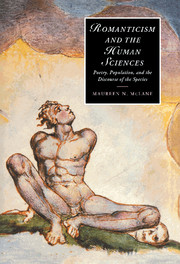Book contents
- Frontmatter
- Contents
- Acknowledgments
- Introduction, or the thing at hand
- Chapter 1 Toward an anthropologic: poetry, literature, and the discourse of the species
- Chapter 2 Do rustics think?: Wordsworth, Coleridge, and the problem of a “human diction”
- Chapter 3 Literate species: populations, “humanities,” and the specific failure of literature in Frankenstein
- Chapter 4 The “arithmetic of futurity”: poetry, population, and the structure of the future
- Chapter 5 Dead poets and other romantic populations: immortality and its discontents
- Epilogue: Immortality interminable: the use of poetry for life
- Notes
- Bibliography
- Index
- CAMBRIDGE STUDIES IN ROMANTICISM
Chapter 1 - Toward an anthropologic: poetry, literature, and the discourse of the species
Published online by Cambridge University Press: 22 September 2009
- Frontmatter
- Contents
- Acknowledgments
- Introduction, or the thing at hand
- Chapter 1 Toward an anthropologic: poetry, literature, and the discourse of the species
- Chapter 2 Do rustics think?: Wordsworth, Coleridge, and the problem of a “human diction”
- Chapter 3 Literate species: populations, “humanities,” and the specific failure of literature in Frankenstein
- Chapter 4 The “arithmetic of futurity”: poetry, population, and the structure of the future
- Chapter 5 Dead poets and other romantic populations: immortality and its discontents
- Epilogue: Immortality interminable: the use of poetry for life
- Notes
- Bibliography
- Index
- CAMBRIDGE STUDIES IN ROMANTICISM
Summary
In his 1797 essay, “Of an Early Taste for Reading,” the political philosopher and novelist William Godwin announced that “Literature, taken in all its bearings, forms the grand line of demarcation between the human and the animal kingdoms.” Five years later, Godwin's lapsed disciple Wordsworth described “the Poet” in the following terms: “He is the rock of defence of human nature; an upholder and preserver, carrying every where with him relationship and love.” What links these two pronouncements, beyond the progressive sympathies of their authors, is their mutual concern for and assertion of “the human.” Godwin proposes literature – taken in all its bearings – as a taxonomic boundary; Wordsworth proposes the poet as the defender, upholder and preserver of “human nature.” In such statements there emerges the structure of a literary anthropology – a conscious conjunction of the literary and the human.
Why “literature” as a “line of demarcation” between species? Why not look to natural history, or to the new chemistry of Humphry Davy, or to Erasmus Darwin's “laws of organic life,” as appropriate means for classifying and distinguishing among forms of life? Further questions arise: is Godwin's “literature” the same as Wordsworth's “poetry”? Why does Wordsworth think human nature requires a “defence,” and how does “the poet” become its primary defender? Such questions begin to articulate the concerns of this book, which explores from several angles the predicament of “literature,” “poetry,” and the human sciences in England circa 1800.
- Type
- Chapter
- Information
- Romanticism and the Human SciencesPoetry, Population, and the Discourse of the Species, pp. 10 - 42Publisher: Cambridge University PressPrint publication year: 2000

